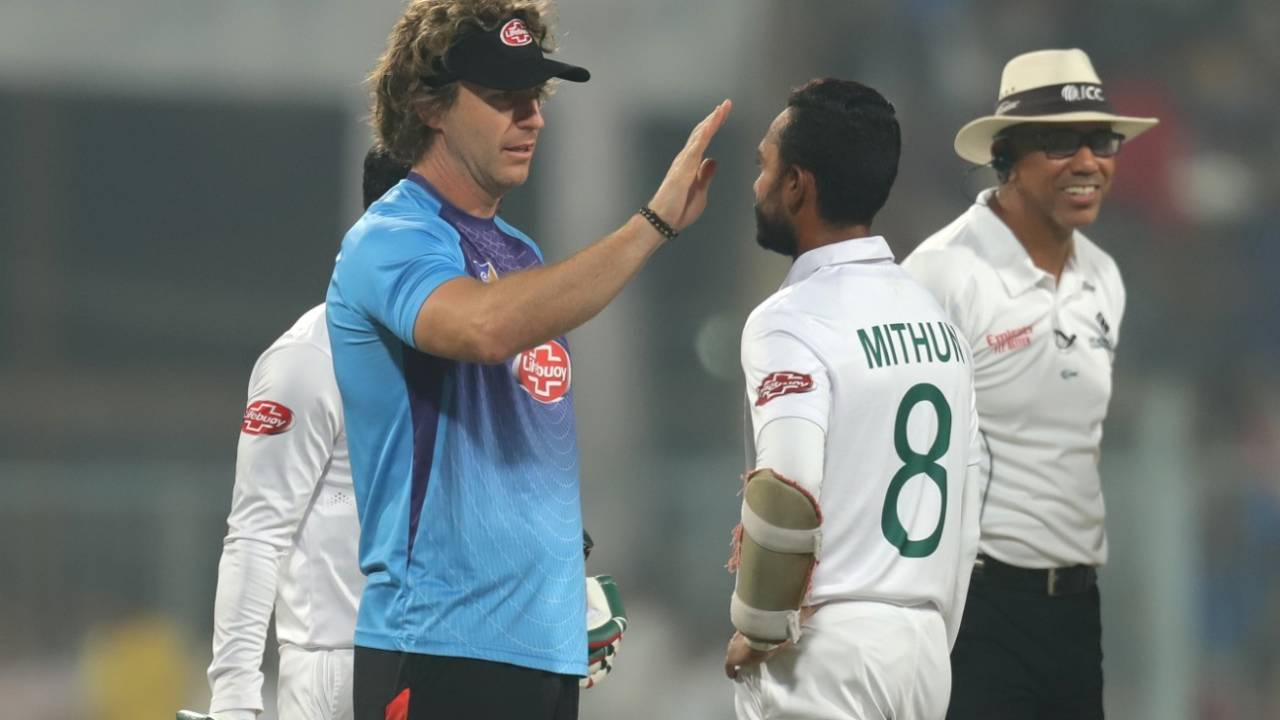Cricket grapples with concussion protocol after Rahim and Mithun blows
It often happens that a batsman chooses to play on after being hit, but that is not a good thing
Varun Shetty at Eden Gardens
23-Nov-2019
Mohammad Mithun took a sickening blow to the side of the head • BCCI
Cricket's newly-introduced protocols for concussion testing and substitutions were in the spotlight on the second day of the Kolkata Test, with two batsmen - Mohammad Mithun and Mushfiqur Rahim - continuing to bat after being struck on their heads by bouncers.
Two other Bangladesh batsmen had already been diagnosed with concussions in the first innings and substituted. In the second innings, Mithun was tested and showed no signs of concussion before coming back out and being dismissed soon after. Bangladesh confirmed that Rahim also showed no early signs of concussion. He batted through to stumps and is currently unbeaten on 59.
Had either batsman been diagnosed with concussion, Bangladesh had only one player - Mustafizur Rahman, a bowler - available on the bench to act as substitute.
Concussion protocols were introduced into the ICC playing conditions on August 1 this year, after years of deliberation following Phil Hughes' death in 2014 and a deeper understanding about brain injuries in the broader world of sports. About two weeks after the playing conditions were amended, Australia's Steven Smith became the first player to be substituted in a Test match with a diagnosed concussion.
While it's common for batsmen to continue to bat after passing initial concussion Tests, in most cases at international level, they have been found later to have batted with a concussion. This was true of Smith during the Ashes, as well as Hashim Amla during the World Cup this year.
In New Zealand, Henry Nicholls was hit on the head but continued batting after two concussion tests - one when he was hit on Friday evening and another just before play on Saturday. The story was a little different last week though when Hamish Rutherford batted on for New Zealand A after being struck, made a fifty, then missed the rest of the match after failing follow-up tests.

Henry Nicholls is hit by a delivery from Jofra Archer•AFP / Getty Images
In the absence of strong mandatory procedures, a lot of power still rests with the players, who would naturally prefer to go on batting. The topic was briefly front and centre as the physio spent a long time chatting with Mithun before he saw the over through and went in unbeaten at tea. Other injuries such as the one Mahmudullah suffered - a hamstring strain - are often readily apparent. The player feels pain immediately and the case for treatment is clear. Concussions and brain injuries though are hard to gauge as the onset of symptoms may be delayed for up to 48 hours.
Cricket's protocols depend on the appointed medical representative of a team - usually the physio - to run standardised tests and submit a report to the match referee in case a player fails the tests. But, as mentioned in the examples earlier, players can sometimes show no signs of trauma until the next day, which means they play on at less than 100% and at great risk of being struck again with the bowlers under no obligation to not bowl bouncers again. To avoid this circumstance, a sport like rugby, for instance, decrees that a player hit on the head has to compulsorily go off and is not allowed back on till he is proven to have no signs of concussion.
Another crucial element of the blows sustained by the Bangladesh batsmen is that this was the first time many of them were playing an international match under lights with the pink ball. Fast bowler Al-Amin Hossain said there were no issues with the visibility as such, but India batsman Cheteshwar Pujara said otherwise.
"I thought light and pink ball had a role to play," Pujara said after the second day's play. "Because as a batsman it's not easy to pick the ball, especially short balls, the kind of pace our fast bowlers have. I think it (the batsmen being hit) is because of the pink ball and playing under lights, because their batters, as far as I know, they haven't even played any first-class games with the pink ball. It's not easy."
Of the four Bangladesh batsmen that were hit during the Test, Mithun and Rahim were the only ones to be hit after sunset, under completely artificial lighting. Mahmudulllah, meanwhile, has been "walking around" in the dressing room and could come back out to bat on Sunday.
Varun Shetty is a sub-editor at ESPNcricinfo
